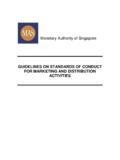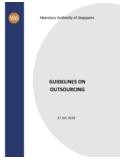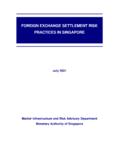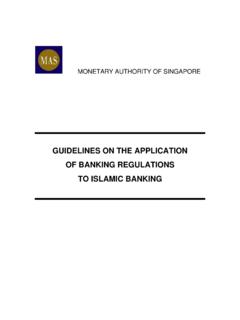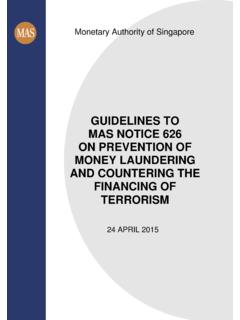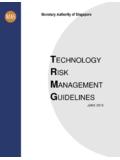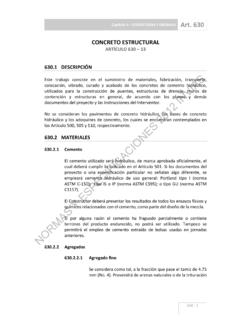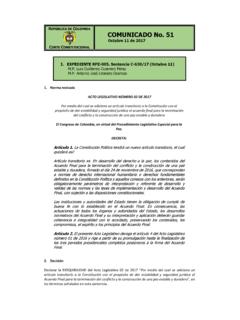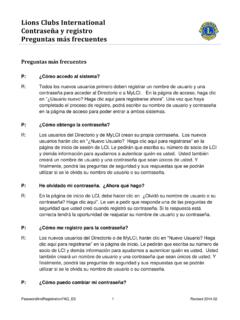Transcription of The Petrochemical Industry in Singapore
1 Occasional Paper No. 14 June 1999 Economics DepartmentMonetary authority of SingaporeThe PetrochemicalIndustry in SingaporeTHE Petrochemical Industry IN SINGAPOREBYDOMESTIC ECONOMY DIVISION*ECONOMICS DEPARTMENTMONETARY authority OF SINGAPOREJune 1999* THE VIEWS IN THIS PAPER ARE SOLELY THOSE OF THE STAFF OF THE DOMESTIC ECONOMY DIVISION, AND SHOULD NOT BE ATTRIBUTED TO THE monetary authority OF Singapore THE monetary authority OF SINGAPOREJEL CLASSIFICATION NUMBER: L65 THE Petrochemical Industry IN SINGAPOREPageEXECUTIVE Petrochemical Industry : AN Petrochemical Industry IN AND IMPLICATIONS12 Appendix 1: Characteristics of Petrochemical Industries in Asia17 Appendix 2:Significant Developments in Singapore 's Chemical Industry19 Appendix 3:Linkages within the Petrochemical Industry22 Appendix 4: Glossary of Petrochemical Terms23 References26 MAS Occasional Paper No. 14, June 99 Economics Department, monetary authority of SingaporeiEXECUTIVE SUMMARY1 petrochemicals play an important role in the modern world:they are essential for the production of a diverse set of products, such assynthetic fibres and rubbers, plastics and resins, solvents and paints,explosives, and many more.
2 In Singapore , the Petrochemical Industry is oneof the fastest growing industries, fuelled by rapid economic development inthe East Asia. It has strong linkages with the domestic economy, especiallywith the petroleum refining in the Petrochemical Industry , however, is highlycyclical. This is due to the fact that investments in the Industry are lumpy asproducers try to exploit the benefits of economies of scale with large , years of shortages and high margins typically result in over-buildingand subsequent years of serious particular, the strong demand and profitability experienced inthe mid-1990s led to massive investment plans for capacity expansion,especially in Asia, in line with projections of strong growth in , many governments in the region aggressively promoted thedevelopment of the Petrochemical and other capital-intensive industries as away to rapidly industrialise their countries.
3 Consequently, ethyleneproduction capacity in Asia expanded by almost twice the global rate in theperiod 1992 to 1997, and the region is expected to become the largestproducer in the world by 2000. The onset of the Asian financial crisis in themiddle of 1997, however, had derailed demand for Petrochemical , together with recent capacity additions across the region, hastened adownturn in the Asian Petrochemical the next few years, Singapore 's Petrochemical firms appearwell-positioned to benefit from the expected pick-up in regional some major projects have been postponed in the region, Singapore isstill forecast to see strong capacity expansion in the Petrochemical Occasional Paper No. 14, June 99 Economics Department, monetary authority of Singaporeii5In the longer term, however, the prospects of Singapore 'spetrochemical Industry depend very much on its competitiveness vis- -visothers in the region.
4 An examination of recent trends shows thatSingapore's share in its traditional ASEAN market appears to be underthreat, with its market share in Malaysia, its most important market forpetrochemicals, sliding in the period 1992 to 1996. This reflected not justgains by major exporter Japan, but also significant inroads made by theASEAN-3 countries. Output from massive capacity expansion in theASEAN-3 countries was not only used to satisfy domestic demand, but wasalso exported. Singapore 's share of the Chinese market, Asia's largestimport market, actually declined in the period 1992 to 1996. This contrastedsharply with gains by Japan, South Korea and the ASEAN-3 , in 1997, Singapore s export shares to most of the key marketsrose significantly, following the start up of PCS second cracker andassociated downstream plants. This helped to boost the growth ofSingapore s domestic chemical exports despite depressed petrochemicaldemand from the crisis-hit regional , Singapore 's Petrochemical plants are fairlycompetitive compared with others in Asia, given their large size and moderntechnology.
5 Moreover, they are currently in a stronger financial position. Inthe longer term, however, the lack of natural gas reserves would be anegative Occasional Paper No. 14, June 99 Economics Department, monetary authority of Singapore11 petrochemicals play an important role in the modern world:they are essential for the production of a diverse set of products, such assynthetic fibres and rubbers, plastics and resins, solvents and paints,explosives, and many more. In Singapore , the Petrochemical Industry is oneof the fastest growing industries, fuelled by rapid economic development inthe East Asia. More recently, however, short-term prospects for the industryhave dimmed considerably in the face of a huge capacity overhang andfaltering demand amidst the Asian financial This paper examines the trends and developments of thepetrochemical Industry in Singapore .
6 Section 2 highlights the trends in theglobal Petrochemical Industry , as well as major players in the 3 focuses on the development of the Industry in Singapore , and theimportance of the Petrochemical Industry to the Singapore economy. Finally,Section 4 discusses the future trends and the competitive position of theindustry in Singapore vis- -vis the other major producers in the Occasional Paper No. 14, June 99 Economics Department, monetary authority of Singapore22 GLOBAL Petrochemical Industry :AN The Petrochemical Industry began to flourish in the 1920s,when petroleum producers and chemical manufacturers started to undertakeresearch on how petroleum and natural gas might be used as a lessexpensive source of organic raw materials than coal. It has since grown tobecome a significant global Industry today, with its products being used asinputs or raw materials in a variety of daily necessities and other industries,such as construction, packaging, clothing, electronics and automobiles.
7 Inthe US, for example, shipments of industrial chemicals and the relatedrubber and plastics Industry grew by an average of and since 1960, compared with growth of in Growth in the Petrochemical Industry , however, is highlycyclical. The Petrochemical cycle tends to last an average of 6-7 years withits last peak seen around the mid-1990s. This is due to the fact thatinvestments in the Industry are lumpy as producers try to exploit the benefitsof economies of scale with large plants. Thus, years of shortages and highmargins typically result in over-building and subsequent years of In particular, the strong demand and profitability experienced inthe mid-1990s led to massive investment plans for capacity expansion,especially in Asia, in line with projections of strong growth in demand. InSoutheast Asia, for instance, demand growth rates for base petrochemicalsaveraged 23% for 1993-1997, according to Industry analyst ChemicalMarket Associates, Inc.
8 Moreover, many governments in the regionaggressively promoted the development of the Petrochemical and othercapital-intensive industries as a way to rapidly industrialise their Petrochemical Industry also offers a way for countries with their own oiland gas industries, such as Indonesia and Malaysia, to move up the value-added ladder. This development transformed the nature of theMAS Occasional Paper No. 14, June 99 Economics Department, monetary authority of Singapore3petrochemical Industry , turning countries that were net importers ofpetrochemicals into net exporters and causing a fundamental shift in theglobal supply-demand Thus, until the early 1990s, Asian ethylene production capacityaccounted for less than 20% of total world production, with the regiondepending on excess petrochemicals in the US and Europe to satisfy itsdemand. However, with major capacity expansion due on stream over thenext few years, Asia is expected to become the largest ethylene producer inthe world by 2000, followed by the US and the Europe.
9 In fact, Asia'sethylene production capacity1 expanded by in the period 1992 to1997, almost twice the rate of global expansion. In spite of the Asianfinancial crisis, ethylene producers are expected to add another billiontonnes of capacity between 1997 and 2000, equivalent to a growth rate per year. (See Table )Table Production Capacity - Selected Countries'000 tonne per annumAverage Growthper annum (%) : Jardine Fleming Research May 97, CMAI & internal forecasts 1 Ethylene capacity is used as an indicator for total petrochemicals capacity. This isthe most capital-intensive product and manufacturers are inclined to maximise theoutput of Occasional Paper No. 14, June 99 Economics Department, monetary authority of Within Asia, Japan is the largest ethylene producer, accountingfor about one-third of total capacity in Asia.
10 South Korea and China are twoother major producers. Together, the three countries make up about three-quarters of Asia's total ethylene capacity. This leaves countries in SoutheastAsia with another 15% share, while India and Taiwan make up 5% each.(See Chart ) However, with Southeast Asian countries pursuingambitious expansion plans, their share of Asian ethylene production looksset to rise to 22% in 2000. Taiwan and India are also embarking on massivecapacity additions that will more than double their current capacity.(Appendix 1 provides a more detailed description of the petrochemicalindustries in each of the Asian countries.)Chart Ethylene Production Capacity, by Country19972000 (Estimated) The onset of the Asian financial crisis in the middle of 1997,however, derailed demand for Petrochemical products. (See Chart )Competition intensified greatly in subsequent quarters as Thai and SouthKorean Petrochemical producers (which had sizeable foreign debtexposures) stepped up their exports aggressively, liquidating inventories toobtain much-needed foreign exchange.
